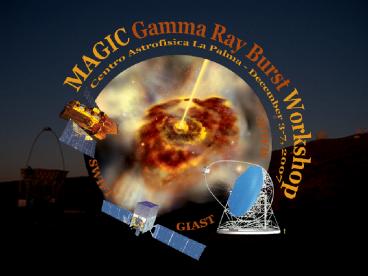Outline: PowerPoint PPT Presentation
1 / 28
Title: Outline:
1
(No Transcript)
2
The MAGIC VHE ?-ray telescope- Prospects for the
observationof Gamma Ray Bursts -
- Outline
- VHE domain
- Cherenkov radiation
- The MAGIC telescope
- Observation of GRBs
- MAGIC key parameters
- MAGIC GRB catalogue
- MAGIC II
- Outlook
Markus Garczarczyk Max-Planck-Institute for
Physics Centro Astrofisica La Palma
CALP December 3rd 2007
3
The Universe in visible light
- Dominant light contribution by our Galaxy
- More than 1012 Galaxies in the background
4
The Universe in X-rays
- In X-rays the Universe shines also outside our
Galaxy - In the last decade more than 105 new sources found
5
The Universe in gamma rays
- Big contribution by the galactic plane in MeV
- Few point like sources at GeV
6
The Gamma Ray Burst distribution
- More than 2700 GRB during 10y observation
- GRBs do not repeat
7
How do we detect cosmic gamma rays?
- At high fluxes and low energies with satellite
experiments - At low fluxes and high energies with ground based
detectors - Large detectors only on the Earth possible
- Earth atmosphere not transparent for X-rays and
?s
8
Detection of HE gamma rays
Using Cherenkov telescopes
?-shower
hadron shower
For comparison night sky background 1012
photons/m2?sr?s
9
How to extract signal from background?-
parametrisation of the images -
Hillas Parameter
Hillas A., Proceedings 19th ICRC, 445 (1985)
10
Cherenkov telescopes worldwide
11
The MAGIC ?-ray telescope
Barcelona IFAE, UA Barcelona, U. Barcelona, IEEC
Barcelona, HU Berlin, Instituto Astrofisica
Canarias,U.C. Davis, U. Dortmund, U. Lodz, UCM
Madrid, MPI München, INFN/ U. Padova, INFN/ U.
Siena, INAF, INR Sofia, Tuorla Observatory,
Yerevan Phys. Institute, INFN/ U. Udine, U.
Würzburg, DESY Zeuthen, ETH Zürich
- Largest Cherenkov telescope 17 m Ø mirror dish
- 3.5 FoV camera with 576enhanced QE PMTs
- Analogue signal transmission
- Fast repositioning for GRBsaverage lt 42 s
- Trigger threshold 50 - 60 GeV
- Sensitivity 2 Crab / 50 h
- ?-PSF 0.1
- Energy resolution 20 - 30
Canary Island La Palma, 2200 m a.s.l.
12
MAGIC key technological elements
Camera with 576 enhanced QE PMTs
- 17m diameter mirror surface (236m2)
13
MAGIC The reflector
- 964 spherical mirror elements
- 49.5 x 49.5 cm2
- All-aluminum, diamond milled, quartz coated,
internal heating - gt82 reflectivity (300-650nm)
- 4 mirrors mounted on 1 panel
- Mirror spot d901cm (pixelinner d3cm)
- Overall reflector
- Parabolic (f/d1)
- Isochronous, maintain time structure of
Cherenkov light flashes (2 nsec) - Better bkg light rejection
14
MAGIC The telescope frame
- Carbon fiber epoxy structure
- Lightweightdish mirrors 20 tonstelescope
65 tons - Stiff
- Allows fast slewing time(180º in both axes in
lt42 s) - Fast follow-up of aGamma Ray Burst
15
Fast repositioning of the telescope
0
2
4
6
8
10
12
14
16
18
20
22
24
26
28
t sec
- Current status
- For safety reason maximal speed 50s
- No reverse mode ? 2x longer for ?Az ? 360
Mirror dish deformations at varying telescope
orientations
16
The Active Mirror Control
- 964 Al-mirrors mounted on 247 panels
- Fixed on three points to the mirror dish
structure - Two actuators per panel
- Laser module
- CCD camera
- Software control
- Look-up tables 10s for refocussing
- Resulting PSF ?7.6 mm
17
Enhanced QE PMT camera
- Matrix of 576 PMTs
- Field of View 3.5o
236 m2 ? 276 m2 !!!
18
Status of the MAGIC telescope
- 2003-2004 Commissioning
- September 2004Start regular data taking
- Smooth data takingif weather allows
19
VHE ?-ray physics overview
gt 40 sources above 100 GeV, rapid growth in
recent years
20
Observation of GRBs
- GRBs are most energetic phenomena
- Bright flashes in ?-rays
- Short lasting (40sec)
- Unpredictable position at the sky
- Satellite alerts distributed over GCN
- Requirements
- Fast reaction time
- Low energy thredshold
- High sensitivity
21
Sensitivity of MAGIC in GRB mode
- Tested on a fake alert by INTEGRAL
- October 11th 2005 Crab Nebula observation
- 46min observation time
- 14? detection _at_ 350 GeV
- Sensitivity of MAGIC5? from a source of 5 C.U.
- 40s for E above 300 GeV
- 90s for E below 300 GeV
22
GCN activity
- For the time between January 2005 and May 2007
- 352 acceptable GCN GRB alerts
- 276 alerts from SWIFT
- 12 fake alert rate by SWIFT
- MAGIC observation rate 9.7 GRBs/month by the
SWIFT satellite
23
MAGIC GRB observations
24
(No Transcript)
25
Prompt emission of GRB 050713a
- Duration 129.1 s
- Start MAGIC observation at T040s
- No ? emission seen
- Detection at broad energy range
- No redshift measurement
- Compatible with ?E-2.14 synchrotron extrapolation
- EBL absorption not included
- Max. 10 of the GRB emissionin VHE domain
Albert J. et al., ApJL 641, L69 (2006)
26
(No Transcript)
27
The Universe is nottransparent for VHE gamma
rays
28
Next Step MAGIC-II
- Aim
- Increase sensitivity by factor 3?
- Lower energy threshold further
- Better energy and angular resolution
- Second telescope MAGIC-II under construction
- Planed completion beginning 2008

